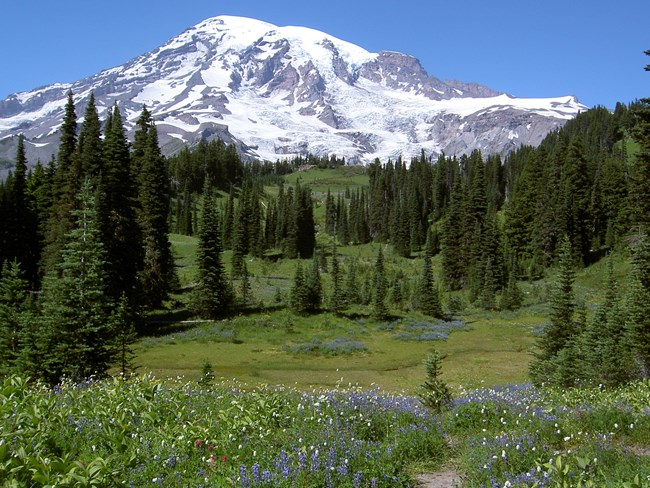
NPS photo
Mount Rainier National Park was established in 1899. The park is 235,625 acres, 97% of which is designated Wilderness. Ascending to 14,410 feet above sea level, Mount Rainier stands as an icon in the Washington landscape. An active volcano, Mount Rainier is the most glaciated peak in the contiguous US, with over 35 square miles of snow and ice and spawning six major rivers.
Approximately 58% of the Park is forested, 23% is subalpine parkland, and the remainder is alpine, half of which is vegetated and the other half consists of permanent snow and ice. Vegetation is diverse, reflecting the varied climatic and environmental conditions encountered across the Park's 12,800-ft elevation gradient.
The North Coast and Cascades Network provides natural resource inventory and monitoring information to help parks make effective, science-based management decisions. Inventories have been completed for birds, fish, mammals, reptiles & amphibians, and vascular plants (see species lists further down the page). Maps and reports detailing Mount Rainier National Park's soils are in progress and are complete for vegetation and geologic resources.
For more information about Mount Rainier National Park, visit the Park website.
Monitored Here
ClimateElk*
Forest Vegetation*
Glaciers
Landbirds
Landscape Change
Mountain Lakes
Subalpine Vegetation
Water Quality
* Elk Monitoring has been suspended with protocol redesign pending
** Forest Monitoring is intermittent due to funding limitations
Publications
Monitoring Reports
Source: NPS DataStore Saved Search 558 (results presented are a subset). To search for additional information, visit the NPS DataStore.
Source: NPS DataStore Saved Search 552 (results presented are a subset). To search for additional information, visit the NPS DataStore.
Source: NPS DataStore Saved Search 555 (results presented are a subset). To search for additional information, visit the NPS DataStore.
Source: NPS DataStore Saved Search 3699 (results presented are a subset). To search for additional information, visit the NPS DataStore.
Source: NPS DataStore Saved Search 3691 (results presented are a subset). To search for additional information, visit the NPS DataStore.
Source: NPS DataStore Saved Search 553 (results presented are a subset). To search for additional information, visit the NPS DataStore.
Source: NPS DataStore Saved Search 567 (results presented are a subset). To search for additional information, visit the NPS DataStore.
Source: NPS DataStore Saved Search 639 (results presented are a subset). To search for additional information, visit the NPS DataStore.
Source: NPS DataStore Saved Search 640 (results presented are a subset). To search for additional information, visit the NPS DataStore.
Inventory Reports
Source: NPS DataStore Collection 531 (results presented are a subset). To search for additional information, visit the NPS DataStore.
Monitoring Protocols
Source: NPS DataStore Collection 7780 (results presented are a subset). To search for additional information, visit the NPS DataStore.
Synthesis, Trend, and Journal Publications
Source: NPS DataStore Saved Search 3605 (results presented are a subset). To search for additional information, visit the NPS DataStore.
Select a Park:
Select a Species Category (optional):
Visit NPSpecies for more comprehensive information and advanced search capability. Have a suggestion or comment on this list? Let us know.
Last updated: August 24, 2023
